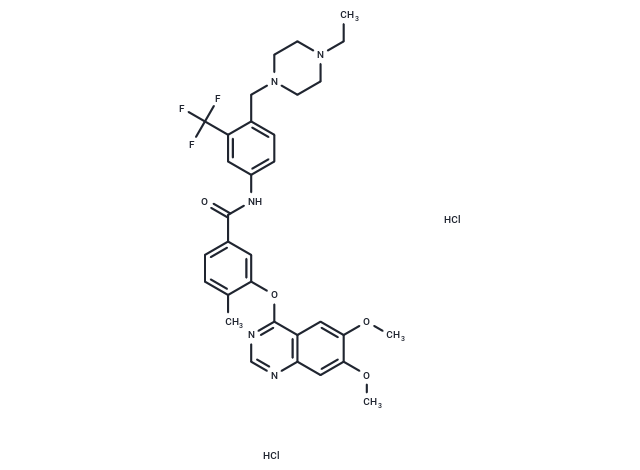Shopping Cart
- Remove All
 Your shopping cart is currently empty
Your shopping cart is currently empty

TL02-59 dihydrochloride is an orally active inhibitor of the Src-family kinase Fgr, with an IC50 of 0.03 nM.

| Pack Size | Price | Availability | Quantity |
|---|---|---|---|
| 10 mg | TBD | 35 days | |
| 50 mg | TBD | 35 days |
| Description | TL02-59 dihydrochloride is an orally active inhibitor of the Src-family kinase Fgr, with an IC50 of 0.03 nM. |
| Targets&IC50 | Lyn:0.1 nM , FGR:0.03 nM , Hck:160 nM |
| In vitro | in TF-1 cells, TL02-59 dihydrochloride (0.1-1000 nM; 6 hours) potently inhibits Fgr autophosphorylation , with paritial inhibition at 0.1-1 nM and complete inhibition above 10 nM. Hck, Lyn and Flt3 are inhibited in the 100 to 1000 nM range. TL02-59 dihydrochloride induces growth arrest in primary AML bone marrow samples. TL02-59 dihydrochloride inhibits the growth and induced apoptosis of AML cell lines expressing this kinase with single-digit nM potency. |
| In vivo | TL02-59 (oral; 1 and 10 mg/kg; for three weeks) entirely eliminates AML cells from the spleen and peripheral blood in a mouse model of AML, while significantly suppressing bone marrow involvement. |
| Molecular Weight | 682.56 |
| Formula | C32H36Cl2F3N5O4 |
| Cas No. | 2415263-06-6 |
| Relative Density. | no data available |
| Storage | Powder: -20°C for 3 years | In solvent: -80°C for 1 year | Shipping with blue ice. |

Copyright © 2015-2025 TargetMol Chemicals Inc. All Rights Reserved.